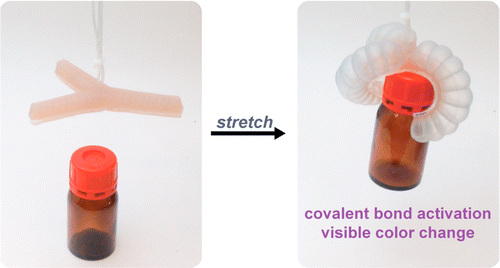Soft robot changes color as it grips and walks

Soft robots can bend, walk and grip. And, unlike their rigid counterparts, some can get flattened and bounce back into shape. Now scientists report a new advance in the journal ACS Applied Materials & Interfaces: a way to make elastic material for soft robots that changes color when it stretches. They say this process opens the door to robot camouflage, new ways to deliver medicines and other applications.
Most commercial robots are stiff, made of hard plastics and metal parts. But the supple robots under development could bridge the gap between today's inflexible varieties and the more fluid and forgiving movements of animals and humans. These machines work when operators pump them with gases or liquids. This inflation results in specific shape changes and desired movements. To impart more versatility to the devices, Stephen L. Craig and colleagues wanted to take advantage of the molecular changes that occur when a robot curls or twists.
The researchers incorporated color-changing compounds in their robots' material that are activated when stretched. This feature could help a robot camouflage itself when it moves. And, because the color change is most intense where the strain on the material is highest, it also can indicate where it's vulnerable to breaking. The researchers note that other compounds could also be added to release drug molecules, make a robot glow or repair the material when it ruptures.
More information: Gregory R. Gossweiler et al. Mechanochemically Active Soft Robots, ACS Applied Materials & Interfaces (2015). DOI: 10.1021/acsami.5b06440
Abstract
The functions of soft robotics are intimately tied to their form—channels and voids defined by an elastomeric superstructure that reversibly stores and releases mechanical energy to change shape, grip objects, and achieve complex motions. Here, we demonstrate that covalent polymer mechanochemistry provides a viable mechanism to convert the same mechanical potential energy used for actuation in soft robots into a mechanochromic, covalent chemical response. A bis-alkene functionalized spiropyran (SP) mechanophore is cured into a molded poly(dimethylsiloxane) (PDMS) soft robot walker and gripper. The stresses and strains necessary for SP activation are compatible with soft robot function. The color change associated with actuation suggests opportunities for not only new color changing or camouflaging strategies, but also the possibility for simultaneous activation of latent chemistry (e.g., release of small molecules, change in mechanical properties, activation of catalysts, etc.) in soft robots. In addition, mechanochromic stress mapping in a functional robotic device might provide a useful design and optimization tool, revealing spatial and temporal force evolution within the robot in a way that might be coupled to autonomous feedback loops that allow the robot to regulate its own activity. The demonstration motivates the simultaneous development of new combinations of mechanophores, materials, and soft, active devices for enhanced functionality.
Journal information: ACS Applied Materials and Interfaces
Provided by American Chemical Society




















